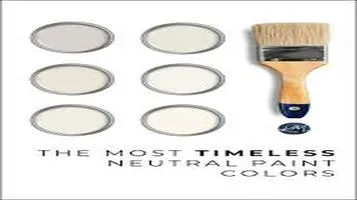The Timeless Appeal of Neutral Paint Colors: A Comprehensive Review
Neutral paint colors are versatile and timeless hues that form the foundation of interior design. These colors include shades like beige, gray, taupe, cream, and white, offering a subtle backdrop that complements a variety of styles and furnishings. Neutrals are celebrated for their ability to create a calming and serene atmosphere, making them ideal for any room in the home. They provide a flexible canvas for accent colors and textures, allowing homeowners to easily update decor without changing the overall paint scheme. Neutral colors can make spaces appear larger and brighter, and their understated nature ensures they never go out of style. Whether in modern, rustic, or classic settings, neutral tones bring a sense of harmony and sophistication to any interior.

Neutral paint colors have long held a significant place in the world of interior design, embodying a timeless elegance and versatility that few other color palettes can match. As trends come and go, the appeal of neutral hues remains steadfast, providing a foundation upon which myriad styles and aesthetics can be built. From cozy cottages to modern minimalist spaces, neutrals offer an unparalleled ability to adapt, harmonize, and enhance. This review delves into the inherent qualities of neutral paint colors, examining their benefits, applications, and enduring popularity.
The Versatility of Neutrals
One of the most compelling reasons for the widespread use of neutral paint colors is their versatility. Neutrals encompass a broad spectrum of shades, including whites, beiges, grays, and taupes. This extensive range allows homeowners and designers to select the perfect hue to complement any design scheme. Whether aiming for a rustic farmhouse look or a sleek, contemporary vibe, there's a neutral color that fits the bill.
For instance, warm neutrals like beige and taupe create a welcoming and cozy atmosphere, ideal for living rooms and bedrooms. On the other hand, cooler shades of gray and off-white can lend a sophisticated, modern feel to spaces such as kitchens and bathrooms. The ability to shift between warm and cool tones ensures that neutrals can suit any climate, mood, or personal preference.
Creating a Blank Canvas
Neutral paint colors serve as an excellent blank canvas, allowing other elements of a room to shine. Furniture, artwork, and decorative accents can take center stage against a neutral backdrop, making it easier to highlight focal points and create visually engaging spaces. This attribute is particularly beneficial for people who enjoy changing their decor frequently, as neutral walls can effortlessly accommodate new styles and trends without necessitating a complete overhaul.
Furthermore, neutral colors can make a space feel larger and more open. Light neutrals, in particular, reflect more natural light, enhancing the sense of airiness and expansiveness in a room. This quality is especially advantageous in smaller spaces or areas with limited natural light.
Timelessness and Resale Value
Another significant advantage of neutral paint colors is their timeless appeal. While bold and vibrant colors can make a striking statement, they often fall victim to changing trends and can quickly become dated. Neutrals, however, have a classic quality that transcends fleeting fashions. This enduring appeal not only ensures that a space remains stylish for years but also positively impacts resale value.
Potential buyers are more likely to be attracted to homes with neutral interiors, as they provide a clean slate that can easily be personalized. A well-chosen neutral palette can make a property more marketable and appealing, potentially leading to a quicker sale and a higher selling price.
Psychological Impact and Comfort
The psychological effects of color should not be underestimated, and neutral tones offer numerous benefits in this regard. Neutrals are often associated with calmness, stability, and relaxation. These qualities make them ideal for creating serene environments, such as bedrooms and meditation spaces. A soft gray or warm beige can evoke a sense of peace and tranquility, promoting rest and relaxation.
In communal areas like living rooms and kitchens, neutrals can foster a sense of community and togetherness. The subtlety of neutral shades encourages conversation and interaction without overwhelming the senses. This balanced and harmonious atmosphere is conducive to both social gatherings and quiet, reflective moments.
Practical Considerations and Maintenance
From a practical standpoint, neutral paint colors are relatively easy to maintain. They tend to show less dirt and wear compared to darker or more vibrant colors, making them a practical choice for high-traffic areas. Touch-ups and repaints are also more straightforward, as matching neutral shades is generally easier than replicating bold or complex colors.
Moreover, the wide availability of neutral paint colors means that finding the right shade is a less daunting task. Most paint brands offer an extensive selection of neutrals, allowing for precise color matching and consistency across different surfaces and rooms.
Conclusion
In conclusion, the enduring popularity of neutral paint colors can be attributed to their remarkable versatility, timelessness, and psychological benefits. They provide a perfect backdrop for a wide range of design styles, enhance the sense of space and light, and create a calming and inviting atmosphere. Whether you're renovating a single room or designing an entire home, neutral paint colors offer a reliable and stylish foundation upon which to build. Their ability to adapt to changing trends while maintaining a classic appeal makes them an invaluable tool in the arsenal of any homeowner or interior designer.






